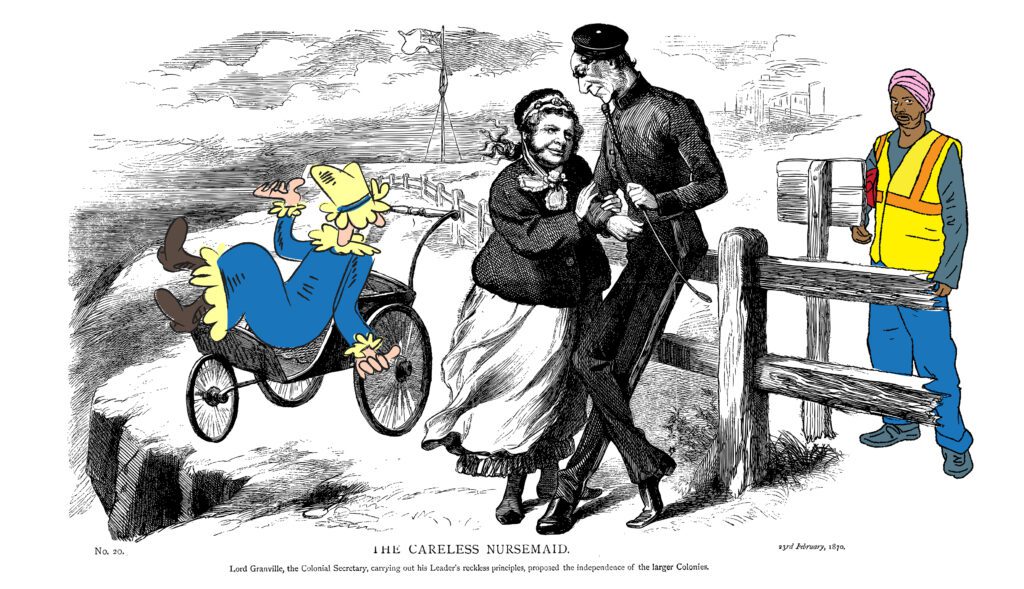Drawing Blood, Drawing Poison, Drawing Fire – a pre-launch Q&A with the artist, Simon Grennan.
Funded by the Arts Council and led by artist Simon Grennan, ‘Drawing Blood’ is a new collaborative art project that creates a new online exhibition of twenty new, original animated artworks. Hosted by Gladstone’s Library, the online exhibition will also be available at Contemporary Art Space Chester and at Aura libraries in North Wales, including Broughton, Buckley, Mold, Deeside, Holywell, Connah’s Quay and Flint.
The new artworks are inspired by a book Simon found in the Gladstone’s Library collections. Dating from 1878, Gladstone from Judy’s Point of View collects cartoons satirising one of the hot topics of the period – liberal political opinion. As one of the major Liberal politicians, William Ewart Gladstone is often in the firing line of Judy’s cartoonists. In the tradition of political artists everywhere their pens puncture any political pomposity, drawing Gladstone (and others) not as respected statesman but as wobbly juggler, unstable acrobat, indecisive whirligig, pram-pushing lady, and many more.
Ahead of the exhibition’s launch, Simon gave us some exclusive insights into the production process. They’ll be posted on this blog each week: for a full list, please visit the project’s home page: https://www.gladstoneslibrary.org/reading-rooms/digital-gladstone/drawing-blood-drawing-poison-drawing-fire
Who is the woman in the hat in some of the images?
The character in blue and white is Judy, traditionally Punch’s wife. Proctor’s and Boucher’s cartoons have a narrator who directs what and how the artists chose to draw. The story in each cartoon – and the way in which it is shown – was under the control of the editor of Judy magazine. Proctor and Boucher were producing the editorial agenda. Throughout its history, Judy magazine maintained the joke that the editor was Judy (Punch’s wife). As such, Judy was the longest standing continuous character in the magazine. Her character, appearance, ideas and opinions developed over years, in a direct editorial relationship with readers. As editor, Judy held the political opinions and social and cultural ideas of the magazine. She frequently delivered these directly to readers or was seen giving assent to the writing and drawing of contributors, by appearing in their copy. Judy was portrayed as an old domestic servant, often the most junior type of servant, a ‘maid of all work’ (known as a ‘slavey’), with experiences of life from the bottom up. Her opinions and humour spring from the contradiction embodied in an old slavey editing a national magazine. It was significant that she was a woman (Judy courted women readers by creating ‘women’s interest’ copy and features) and significant that she was working class (that is, someone who could not afford a domestic servant of her own). The actual editors of the magazine were described as “Judy’s office boy.”
Pwy yw’r fenyw mewn het yn rhai o’r lluniau?
Y cymeriad mewn glas a gwyn yw Judy, gwraig Pwnsh yn draddodiadol. Mae cart?ns Proctor a Boucher yn cynnwys adroddwr sy’n dweud beth a sut mae’r arlunwyr yn dewis tynnu llun. Roedd y stori ym mhob cart?n – a’r ffordd yr oedd yn cael ei dangos – o dan reolaeth golygydd cylchgrawn Judy. Roedd Proctor a Boucher yn cynhyrchu’r agenda olygyddol. Drwy gydol ei hanes, roedd cylchgrawn Judy yn jocio mai’r golygydd oedd Judy (gwraig Punch). Felly, Judy oedd y cymeriad hir sefydlog parhaus yn y cylchgrawn. Roedd ei chymeriad, ymddangosiad, syniadau a barn yn datblygu dros y blynyddoedd, mewn perthynas olygyddol uniongyrchol gyda darllenwyr. Fel golygydd, roedd gan Judy farn wleidyddol a syniadau cymdeithasol a diwyllianol y cylchgrawn. Roedd yn cyflwyno’r rhain yn uniongyrchol i ddarllenwyr neu’n cael ei gweld yn rhoi cydsyniad i ysgrif a lluniau cyfranogwyr, drwy ymddangos yn eu copi. Roedd Judy yn cael ei phortreadu fel hen forwyn ddomestig, yn aml y math ieuengaf o forwyn, ‘morwyn holl waith’ (a alwyd yn ‘slafiwr’), gyda phrofiadau bywyd o’r gwaelod i fyny. Mae ei barn a’i hiwmor yn dod o wrthddywediad mewn hen slafiwr yn golygu cylchgrawn cenedlaethol. Roedd yn arwyddocaol ei bod yn fenyw (roedd Judy yn caru darllenwyr benywaidd drwy greu copi a nodweddion ‘diddordeb menywod’) ac yn arwyddocaol ei bod yn ddosbarth gwaith (hynny yw, rhywun na fyddai’n gallu fforddio morwyn ei hun). Roedd y golygyddion cylchgrawn eu hunain yn cael eu disgrifio fel “Judy’s office boy.”
